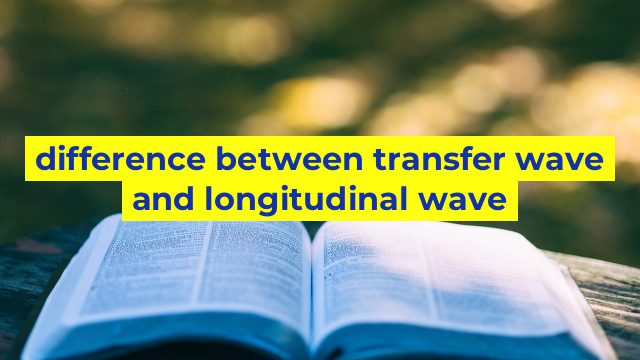The Differences Between Transfer Waves and Longitudinal Waves
When it comes to describing waves, there are two types that scientists often talk about: transfer waves and longitudinal waves. While they may seem similar at first glance, there are key differences between the two that are worth understanding.
Transfer Waves
Transfer waves, also known as mechanical waves or simply waves, are characterized by a back-and-forth motion that moves energy from one point to another. They require a medium to travel through, such as air or water, and as they move through that medium, they cause molecules to oscillate in a specific direction.
As they do this, they create a physical disturbance that moves through the medium, and this is what we perceive as the wave itself. Transfer waves can be either transverse or longitudinal, with transverse waves creating motion perpendicular to their direction of propagation, and longitudinal waves causing motion parallel to their direction of propagation.
Some common examples of transfer waves include sound waves and seismic waves (waves that move through the earth during an earthquake). In both cases, energy is transferred from one point to another through the motion of particles in a medium.
Longitudinal Waves
Longitudinal waves are a specific type of transfer wave that create motion that is parallel to their direction of propagation. This means that as they travel through a medium, the motion they create is in the same direction as the wave itself.
The classic example of a longitudinal wave is a sound wave, which creates areas of high and low pressure as it travels through the air. As the wave moves forward, it compresses the air molecules in front of it, creating an area of high pressure. As it passes, it expands the air molecules behind it, creating an area of low pressure.
This back-and-forth motion of compressing and expanding the medium is what we perceive as sound. Other examples of longitudinal waves include seismic waves and waves in springs or other elastic materials.
The Bottom Line
While transfer waves and longitudinal waves may seem to be just two different ways of describing the same thing, there are some important differences to keep in mind. Transfer waves are any waves that transfer energy from one point to another, while longitudinal waves create motion that is parallel to their direction of propagation. Understanding these differences is key to understanding how waves work and how they are important in many different fields of science and engineering.
Table difference between transfer wave and longitudinal wave
| Transfer Waves | Longitudinal Waves |
|---|---|
| Transfer waves transfer energy by moving matter from one place to another. | Longitudinal waves transfer energy by particles vibrating parallel to the direction of wave propagation. |
| Examples include ocean waves and seismic waves. | Examples include sound waves and pressure waves. |
| Transfer waves require a medium to travel through (solid, liquid, or gas). | Longitudinal waves can travel through any medium including vacuum. |
| Transfer waves can be reflected, refracted, and diffracted. | Longitudinal waves can be reflected and refracted but not diffracted because they require a medium. |
| Transfer waves have a perpendicular motion of particles to the direction of wave propagation. | Longitudinal waves have a parallel motion of particles to the direction of wave propagation. |
